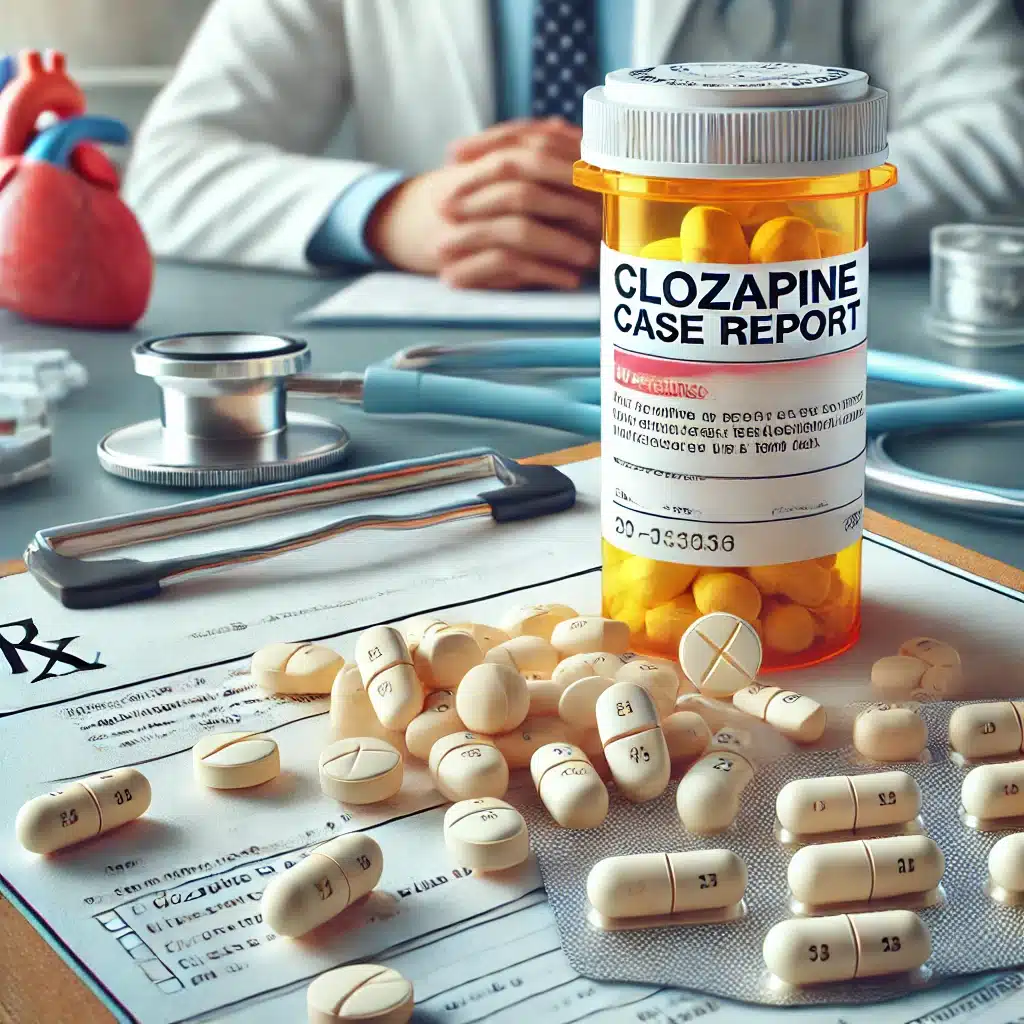TLDR: This case study reports the highest recorded nonfatal clozapine overdose (10,000 mg) in an elderly patient, causing significant fluctuations in blood concentration levels following treatment.
Highlights:
- A 71-year-old female ingested 10,000 mg of clozapine, significantly above typical overdose levels, leading to an initial blood concentration of 5200 μg/L.
- Despite initial treatment, blood clozapine levels spiked unexpectedly from 1847.11 μg/L to 5554.15 μg/L after the second hemoperfusion, highlighting unusual pharmacokinetic behavior.
- The patient underwent multiple hemoperfusion sessions, fluid infusion, and diuresis, with treatment adjusted based on continuous therapeutic drug monitoring (TDM) to manage the severe overdose.
- Elevated inflammatory markers, including procalcitonin (PCT) and NT-ProBNP, indicated systemic inflammation that likely contributed to the abnormal increase in clozapine levels.
- After 14 days of intensive care and adaptive treatment, the patient’s clozapine levels stabilized within the therapeutic range, and her mental state improved, leading to a transfer to the general ward for further recovery.
Source: BMC Psychiatry (2024)
Highest Clozapine Overdose Reported (10,000 mg) in Elderly Woman (Case Report)
History
A 71-year-old female with a long-standing history of depression was admitted to the emergency room after an intentional overdose of clozapine.
The patient had ingested 400 clozapine tablets, each containing 25 mg, resulting in a total dose of 10,000 mg.
Her medical history included diabetes mellitus, hypertension, coronary artery disease, and a history of stenting.
Onset & Diagnosis
Approximately six hours post-ingestion, the patient exhibited primary symptoms of nausea, vomiting, and impaired consciousness.
Initial examination revealed a drowsy state, hypotension, muscle tremors, and tachycardia.
Blood analysis using liquid chromatography-mass spectrometry revealed an initial clozapine concentration of 5200 μg/L, significantly above the therapeutic range.
A diagnosis of acute clozapine overdose was made.
Treatment
Initial treatment included gastric lavage and hemoperfusion, which reduced the clozapine concentration to 1847.11 μg/L.
Despite this intervention, the patient’s clinical symptoms did not improve significantly, and a subsequent blood test after the second hemoperfusion showed an unexpected spike to 5554.15 μg/L.
The patient exhibited systemic inflammatory responses, including elevated procalcitonin (PCT) and N-terminal Pro-Natriuretic Peptide (NT-ProBNP).
Continuous monitoring and additional hemoperfusion sessions were recommended.
Due to persistent high clozapine levels and signs of systemic infection, treatment was adjusted to twice-daily hemoperfusion, along with fluid infusion and diuresis.
Over the following days, clozapine levels gradually decreased, reaching 1808.37 μg/L by Day 8.
However, discontinuation of hemoperfusion led to another spike in blood levels, prompting the resumption of aggressive treatment measures.
By Day 11, clozapine concentration had decreased to 1084.58 μg/L.
Recovery
After 14 days of intensive care and routine maintenance therapy, the patient’s clozapine levels stabilized within the therapeutic range, and her mental state improved.
She was eventually transferred from the intensive care unit to the general ward for continued treatment until full stabilization.
Prevalence of Clozapine Overdose

Clozapine overdose is relatively rare compared to other antipsychotic medications, primarily due to its restricted use and stringent monitoring requirements.
However, instances of clozapine overdose, whether accidental or intentional, have been documented.
Overdose cases are particularly concerning due to the drug’s narrow therapeutic index and the significant variability in individual metabolism and clearance rates.
Reports indicate that clozapine overdose often occurs in individuals with a history of psychiatric disorders who may have higher risks of self-harm or suicide attempts.
Common Signs & Symptoms of Clozapine Overdose
Recognizing the signs and symptoms of clozapine overdose is critical for prompt and effective intervention. Common signs and symptoms include:
Cardiovascular Symptoms
- Hypotension: A significant drop in blood pressure is common and can lead to dizziness and fainting.
- Tachycardia: Rapid heart rate is frequently observed and can be accompanied by palpitations.
- Arrhythmias: Irregular heartbeats may occur, potentially leading to more severe cardiovascular complications.
Neurological Symptoms
- Drowsiness and Sedation: Overdosed individuals often exhibit extreme drowsiness, lethargy, and difficulty staying awake.
- Confusion and Agitation: Mental confusion, restlessness, and agitation are common.
- Seizures: There is a risk of seizures, particularly in severe cases of overdose.
- Coma: In extreme cases, patients may lose consciousness and enter a coma.
Gastrointestinal Symptoms
- Nausea and Vomiting: These are common early symptoms of overdose.
- Hypersalivation: Excessive salivation can occur, leading to drooling.
Respiratory Symptoms
- Respiratory Depression: Slowed or difficult breathing is a serious concern and can lead to hypoxia (low oxygen levels in the blood).
Hematological Symptoms
- Leukopenia: A decrease in white blood cell count can occur, although this is more typical with long-term use rather than acute overdose.
Other Symptoms
- Hyperthermia: Elevated body temperature may be observed.
- Muscle Rigidity: Increased muscle tone and stiffness are possible.
- Metabolic Acidosis: A disturbance in the body’s acid-base balance can develop.
Lethal Dose of Clonidine in Humans
Determining the lethal dose of clozapine in humans is challenging due to the variability in individual tolerance and metabolism. However, some general insights can be noted:
- Therapeutic Dose Range: The typical therapeutic dose for clozapine ranges from 350 to 600 μg/L in blood concentration, with levels above 1000 μg/L being considered potentially toxic.
- Reported Overdose Cases: Clinical reports have documented nonfatal overdoses with blood concentrations significantly higher than the therapeutic range. For instance, blood levels reaching 5200 μg/L have been reported in nonfatal cases, as seen in the current case study.
- Estimated Lethal Dose: While there is no universally accepted lethal dose, doses exceeding 2000 mg are generally considered life-threatening. Fatalities have been reported with ingestions as low as 4000 mg, though survival is possible with prompt and aggressive medical intervention.
Clozapine: Mechanisms of Action

Clozapine is a second-generation antipsychotic that exerts its therapeutic effects through multiple mechanisms:
- Dopamine Receptor Antagonism: Clozapine primarily blocks dopamine D4 receptors in the mesolimbic pathway, which helps alleviate positive symptoms of schizophrenia, such as hallucinations and delusions. Unlike typical antipsychotics, clozapine has a lower affinity for D2 receptors, resulting in fewer extrapyramidal side effects.
- Serotonin Receptor Antagonism: Clozapine blocks 5-hydroxytryptamine (5-HT) receptors, particularly 5-HT2A and 5-HT2C receptors. This action helps improve negative symptoms of schizophrenia, such as social withdrawal and lack of motivation, by increasing dopamine release in the prefrontal cortex.
- Adrenergic and Histaminergic Receptor Antagonism: Clozapine also antagonizes alpha-adrenergic and histaminergic receptors, contributing to its sedative effects and potential for orthostatic hypotension.
- Muscarinic Receptor Antagonism: By blocking muscarinic receptors, clozapine can lead to anticholinergic effects such as dry mouth, blurred vision, constipation, and urinary retention.
- Glutamatergic Modulation: Emerging evidence suggests that clozapine may modulate the glutamatergic system, which could play a role in its efficacy for treatment-resistant schizophrenia.
Conclusion: Clozapine Overdose in Elderly Woman
This case report highlights the challenges of managing a severe clozapine overdose in an elderly patient.
Despite the initial aggressive treatment with gastric lavage and hemoperfusion, unexpected fluctuations in blood clozapine levels underscored the importance of continuous therapeutic drug monitoring (TDM).
Factors such as systemic inflammation, delayed gastric emptying, and inhibited drug clearance due to age and chronic conditions contributed to the abnormal concentration patterns observed.
The patient’s survival and eventual recovery were facilitated by persistent and adaptive treatment strategies, including repeated hemoperfusion and comprehensive supportive care.
This case underscores the critical need for vigilance in monitoring and managing clozapine overdose, particularly in elderly patients with complex medical histories.
References
- Study: Abnormal blood concentration changes in a 71-year-old female who survived a 10,000mg overdose of clozapine: a case report (2024)
- Authors: Yonghua Wu et al.







